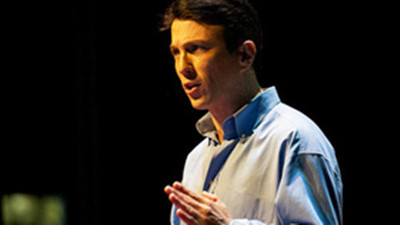(单词翻译:单击)
视频文本
And I would argue, in the future, we'll have wearable devices in our clothes,monitoring ourselves 24/7.
我要说,在将来,我们将有穿在衣服里的装置,全天候检测我们的身体。
And just like we have the OnStar system in cars,
就像我们现在车里用的OnStar系统,
your red light might go on-it won't say check engine though.
你的红灯会亮起来-它虽然不会说检查发动机。
It's going to be check your body light,and go in and get it taken care of.
它将会是检查身体灯,亮起来就得小心。
Probably in a few years, you'll check into your mirror and it's going to be diagnosing you.
也许几年之后,你照镜子的时候它就会诊断你。
For those of you with kiddos at home,how would you like to have the wireless diaper that supports your too much information, I think, than you might need.
对于你们中在家带小孩的,你会觉得无线网络尿布会帮你大忙。我认为有比你需要的多得多的信息。
But it's going to be here.
但是会是这里。
Now we've heard a lot today about new technology and connection.
现在我们已经听了太多技术和连接,
And I think some of these technologies will enable us to be more connected with our patients,and take more time,and actually do the important human touch elements of medicine,as augmented by these sorts of technologies.
我认为一些技术将会使我们和病人联系得更好,节约更多的时间,实际上增进医学交流中重要的人与人之间的交互,这些技术都能增强这些交流。
Now we've talked about augmenting the patient, to some degree.
现在我们在某种程度上谈过了与患者的增进交流。
How about augmenting the physician?
那与医生的增进交流呢?
We're now in the era of super-enabling the surgeon who can now go inside the body and do things with robotic surgery, which is here today,at a level that was not really possible even five years ago.
我们正处在超能医生时代,他们能进入身体内部用机器人做手术,如今成为现实,在过去这是不可能完成的。即使在5年前。
Now this is being augmented with further layers of technology like augmented reality.
现在这种技术被多重技术所增强,就像增强现实一样。
So the surgeon can see inside the patient, through their lens,where the tumor is, where the blood vessels are.
医生能通过镜头看到患者身体内部,肿瘤在哪里,血管在哪里。
This can be integrated with decisions support.
这可以和决策支持合并在一起。
A surgeon in New York can be helping a surgeon in Amsterdam, for example.
例如,纽约的一个医生能帮助阿姆斯特丹的另一个医生做手术。
And we're entering an era of really, truly scarless surgery called NOTES,where the robotic endoscope can come out the stomach and pull out that gallbladder all in a scarless way and robotically.
我们正处在一个叫做NOTES的真正无疤手术时代,机器人的内窥镜能穿过胃部切除胆囊,全程都是机器人化无疤方式。
And this is called NOTES, and this is coming basically scarless surgery,as mediated by robotic surgery.
这就叫做NOTES,这就是基本无疤手术,通过机器人手术来实现。
Now how about controlling other elements?
现如今控制其他元素会怎么样呢?
For those who have disabilities-the paraplegic,there's the era of brain-computer interface, or BCI,where chips have been put on the motor cortex of completely quadriplegic patients and they can control a curser or a wheelchair or, eventually, a robotic arm.
对于残疾人-半身不遂,这是大脑-计算机交互时代,或者叫BCI,在大脑皮层运动区放置芯片对四肢瘫痪者,他们能够控制一个遥控器或者一个轮椅或者,最终,一个机器手臂。
And these devices are getting smaller and going into more and more of these patients.
这些装置变得越来越小,可以植入越来越多的患者体内。
Still in clinical trials, but imagine when we can connect these,for example, to the amazing bionic limb,such as the DEKA Arm built by Dean Kamen and colleagues,which has 17 degrees of motion and freedom and can allow the person who's lost a limb to have much higher levels of dexterity or control than they've had in the past.
虽然仍在临床实验阶段,但是设想当我们能连接这些技术,例如,令人惊叹的仿生学假肢,像迪安卡门和他的同事们所设计的DEKA手臂,它有17度的移动和灵活度,能够让失去一个肢体的人有更高水平的灵活和控制度,比起他们过去曾有过的手臂。
So we're really entering the era of wearable robotics actually.
我们实际上真正进入了可穿用的机器人时代。
If you haven't lost a limb-you've had a stroke, for example,you can wear these augmented limbs.
如果你没有失去一个肢体-比方说,你有过中风,你可以穿用这些假肢。
Or if you're a paraplegic-like I've visited the folks at Berkley Bionics,they've developed eLEGS.
或者如果你是一个半身不遂患者-像我拜访过的在伯克利仿生学实验室工作的同事们,他们发明了电子腿eLEGS。
I took this video last week. Here's a paraplegic patient actually walking by strapping on these exoskeletons.
我上周拍了这段视频。这是一个半身不遂患者正在走路通过穿上这些盔甲。
He's otherwise completely wheelchair-bound.
如果不穿这些盔甲他完全得依靠轮椅。
And now this is the early era of wearable robotics.
现在是可穿用机器人时代的早期。
And I think by leveraging these sorts of technologies,we're going to change the definition of disability to in some cases be superability, or super-enabling.
我认为通过采用这些技术,我们能够改变残疾的定义,在某些情况下成为超常或者超能。
This is Aimee Mullins, who lost her lower limbs as a young child,and Hugh Herr, who's a professor at MIT who lost his limbs in a climbing accident.
这是艾米马林斯,在小时候她失去了下肢,休贺尔,麻省理工的教授在一次攀岩事故中失去了肢体。
And now both of these can climb better, move faster, swim differently with their prosthetics than us normal-abled persons.
现在他们可以比我们正常人爬得更好,移动得更快,以不同的姿势游泳,通过修复手术。
Now how about other exponentials?
其他的指数技术怎么样呢?
Clearly the obesity trend is exponentially going in the wrong direction,including with huge costs.
很明显肥胖趋势朝错误的方向指数发展,包括巨额支出。
But the trend in medicine actually is to get exponentially smaller.
但是在医学上这种趋势正在指数减少。
So a few examples: we're now in the era of Fantastic Voyage,the iPill.
有几个例子:我们现在处在奇异旅程时代,iPill。
You can swallow this completely integrated device.
你可以吞下这个完全集成的装置。
It can take pictures of your GI system,help diagnose and treat as it moves through your GI tract.
它能在你的消化道里拍照片,当它通过你的消化道的时候帮助你诊断和治疗。
We get into even smaller micro-robots that will eventually autonomously move through your system again and be able to do things that surgeons can't do in a much less invasive manner.
我们感兴趣更小的微型机器人将会最终自动通过你的消化系统能做到医生做不到的事情用一种痛苦少得多的方式。
Sometimes these might self-assemble in your GI system and be augmented in that reality.
有时这些装置也许可以在你的消化系统自行组装从而增强其使用价值。
On the cardiac side, pacemakers are getting smaller and much easier to place so you don't need to train an interventional cardiologist to place them.
对于心脏手术,起搏器正变得更容易放置,因此你不需要训练一个介入心脏医师去放置它们。

And they're going to be wirelessly telemetered again to your mobile devices so you can go places and be monitored remotely.
它们将会被你的手机遥控,你可以去任何地方并远程遥控。
These are shrinking even further.
这些装置正在被变得更小。
Here's one that's in prototyping by Medtronic that's smaller than a penny.
这是一个Medtronic制作的样品,比一分硬币还小。
Artificial retinas, the ability to put these arrays on the back of the eyeball and allow the blind to see.
人工视网膜的功能是把光线集中在眼球后面从而让失明者恢复视力。
Again, in early trials, but moving into the future.
虽然仍在早期试验阶段,但是有很好的前景。
These are going to be game changing.
这些技术将会是革命性的。
Or for those of us who are sighted,how about having the assisted-living contact lens?
对于我们中的那些视力有问题的人,有了这些辅助生活的隐形眼镜会怎样呢?
BlueTooth, WiFi available-beams back images to your eye.
用蓝牙,无线网络-投射图像到你的眼球上。
视频及简介
视频简介:
在马斯特里赫特的TED会议上,丹尼尔·克拉夫特快速展示了在未来几年医学上的革新,通过新工具,测试和应用程序把诊断信息直接带到患者的床边。


